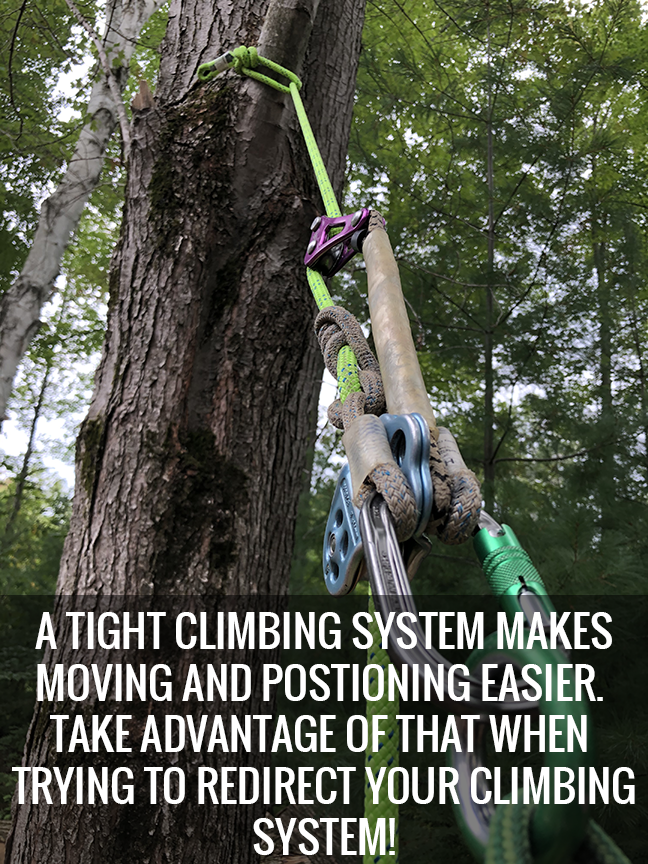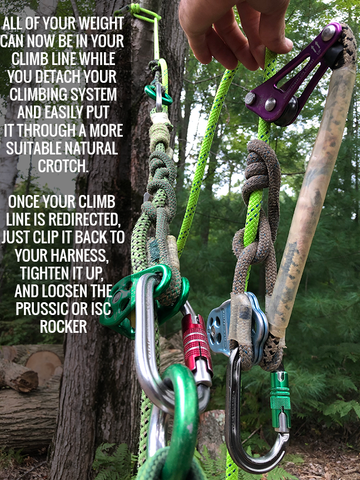
Making Redirects More Comfortable
There have been way too many times that I have been cruising around in the canopy, clearing out dead wood or broken branches, when I realize that a redirect would put me in a way better position than just trying to fight my way out to the tips of the limbs while working with bad and potentially dangerous rope angles. The whole point of a redirect is to change the angle of your climbing line, whether that be by simply going through a natural crotch up in the tree or by means of installing some sort of hardware redirect like a sling with a carabiner attached to it. These are both great ways of changing the angle of your climb line to make your climbing safer but is there any way to make setting the redirect any safer or more comfortable?
A friend of mine had posted some images online that showed a super simple way to make setting a redirect way more comfortable and quite a bit safer as well. So, one of my biggest issues with doing any sort of redirect is that most of the time, I’m in a relatively precarious spot when trying to get everything set up. Every climber knows that a high tie in point (TIP) is best for work positioning. The same usually goes for redirects as well. You want a high redirect that will allow you the greatest amount of movement throughout the tree. You also want your redirect to try to position you on top of or close to the work you want to do. There are times when I will redirect over a limb that I wouldn’t trust hanging all of my body weight off of but by using rope angles the limb is solid for a redirect. How do I go about standing on that limb without breaking it while I try to set the redirect?!?!
So in saying all of this, many times, I am trying to pull my climbing system through a natural crotch that is out on a limb but also higher in the canopy. Setting the redirect consisted of me getting into a relatively comfortable position, lanyarding into the tree, unclipping my climbing system from my harness, putting the climbing system through the natural crotch and then reattaching it to my harness. The issue that becomes difficult is trying to stay balanced or comfortable while doing all of this work to get a better rope angle. The biggest issue I have with these situations is losing my ability to lean into my climbing system because I no longer have it attached to me. When we are climbing, we use our lanyard and our climb line as well as our arms and legs to help triangulate ourselves when positioning. When we disconnect one of those components, we get pretty wonky and uncomfortable.

The pictures that were posted online showed the climber out on a limb with their climbing system disconnected from their harness. On their climb line between their climbing system and their TIP was an ISC Rocker that was attached to a sling connected to the bridge on their harness. This allowed the climber to still use their climb line to help position them as well as hold most of their weight while they easily and comfortably put their climbing system through the natural crotch above them! Sick! This little device can easily and quickly be attached to your climb line to help you position while you are making your climbing a bit easier.

The Rocker has been used in Rope Access applications for quite some time but arborists are starting to find uses for it like mentioned above. The Rocker allows a rope access tech to ascend up a rope while the Rocker acts as a backup. It follows the climber up a separate line and in the event of a fall, easily rocks downward and locks on the rope preventing the tech from falling further. Now tree climbers are starting to find some interesting uses just like we always do!

You could also use a prussic to attach yourself to your climb line while redirecting. The biggest downfall to this method is that it takes a bit more time to install the prussic or endless loop prussic to your climb line. If you are looking for a low budget option for trying out this neat little trick, try out a prussic. If you want to be super efficient, pick up a Rocker and let us know how it works for you! Stay safe!

Comments
Leave a comment